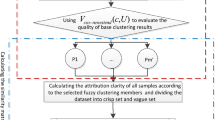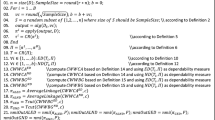Abstract
Clustering ensemble algorithm is an effective way to improve the accuracy, stability and robustness of clustering results. It can get better results by fusing multiple homogenous or heterogeneous base clustering models. In this paper a clustering ensemble algorithm based on grey relation analysis is proposed. Through constructing a grey-linked matrix, the relationship between the data objects and all clusters can be connected, then the basic clustering results can be integrated. After that the appropriate consensus function is used to get the integrated clustering results by partitioning the matrix finally. In contrast to other clustering ensemble models, the proposed algorithm has higher accuracy and gets better stability and robustness after validating on several datasets from UCI. Moreover, the proposed algorithm can effectively avoid the category labels’ matching problem that’s in traditional clustering ensemble algorithms, so the clustering performance has been greatly improved.

















Similar content being viewed by others
References
Ling, G., Wang, M. C., & Feng, J. Y. (2011). A cluster ensemble method based on co-occurrence similarity. Computer Application, 31(2), 441–445.
Fred, A. L., & Jain, A. K. (2005). Combining multiple clusterings using evidence accumulation. IEEE Transactions on Pattern Analysis and Machine Intelligence, 27(6), 835–850.
Mimaroglu, S., & Erdil, E. (2011). Combining multiple clusterings using similarity graph. Pattern Recognition, 44(3), 694–703.
Zhong, C., Yue, X., Zhang, Z., et al. (2015). A clustering ensemble: Two-level-refined co-association matrix with path-based transformation. Pattern Recognition, 48(8), 2699–2709.
Ayad, H. G., & Kamel, M. S. (2010). On voting-based consensus of cluster ensembles. Pattern Recognition, 43(5), 1943–1953.
Hore, P., Hall, L. O., & Goldgof, D. B. (2009). A scalable framework for cluster ensembles. Pattern Recognition, 42(5), 676.
Zhou, Z. H., & Tang, W. (2006). Clusterer ensemble. Knowledge-Based Systems, 19(1), 77–83.
Yang, Y., Feng, C., Jia, Z., et al. (2014). A link-based fuzzy clustering ensemble. Journal of University Electronic Science and Technology of China, 43(6), 887–892.
Deng, J. L. (1998). Grey group decision in grey relational space. Journal of Grey System, 10(3), 177–182.
Author information
Authors and Affiliations
Corresponding author
Rights and permissions
About this article
Cite this article
Shi, T., Jiang, W. & Luo, P. A Method of Clustering Ensemble Based on Grey Relation Analysis. Wireless Pers Commun 103, 871–885 (2018). https://doi.org/10.1007/s11277-018-5484-0
Published:
Issue Date:
DOI: https://doi.org/10.1007/s11277-018-5484-0




